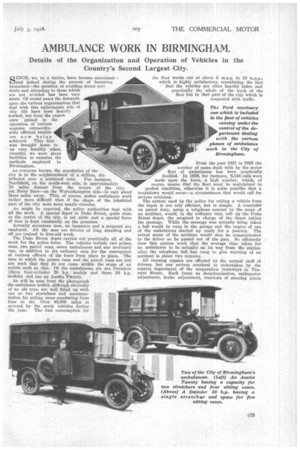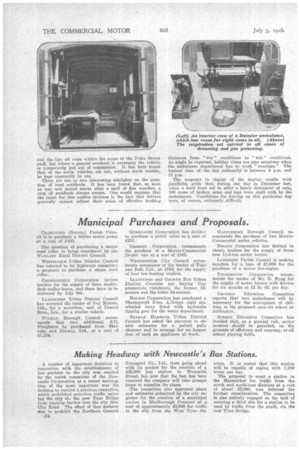AMBULANCE WORK IN BIRMINGHAM.
Page 45

Page 46

If you've noticed an error in this article please click here to report it so we can fix it.
Details of the Organization and Operation of Vehicles in the Country's Second Largest -City.
SINCE, we, as a nation, have became motorized— and indeed during the process of becoming motorized—the question of avoiding street accidents and attending to those which are not avoided has been very acute. Of recent years the demands upon the various organizations that deal with this unfortunate side of city life have been heavily worked, but from the experience gained in the operation of various systems extraordinarily efficient results are now being achieved. This fact was brought home to us very forcibly when, recently, we were given facilities to examine the methods employed in Birmingham.
As everyone knows, the population of the city is in the neighbourhood of a million, dis tributed over a scattered area. For instance, Northfield, on the south-west side, is approximately 10 miles distant from the centre of the city, yet. Perry Barr—on the Wolverhampton side—is only about three miles away. This, of course, makes ambulance work rather more difficult than if the shape of the inhabited part of the city were more nearly circular.
As might be expected, the police authorities deal with all the work. A special depot in Duke Street, quite close to the centre of the city, is set aside and a special force of men is kept constantly on the premises.
Actually seventeen men, an inspector and a sergeant are employed. All the men are drivers of long standing and all are trained in first-aid work.
The Duke Street depot carries out practically all of the work for the police force. The vehicles include two prison vans, two patrol vans, seven ambulances and one mortuary van, in addition to six ordinary cars for the conveyance of various officers of the force from place to place. The uses to which the prison vans and the patrol vans are put are such that they do not come within the scope of an article such as this. Of the ambulances, six are Daimlers (three four-cylinder 20 h.p. models and three 30 h.p. models) and one an Austin Twenty.
• As will be seen from the photograph • the ambulance bodies, although obviously of an old type, are well fitted up with one or two stretchers and accommodation for sitting cases numbering from four to six. Over 40,000 miles is covered by the seven vehicles during the year. The fuel consumption for
the fleet works out at about 8 m.p.g. to 10 m.p.g., which is highly satisfactory, considering the fact that the vehicles are often heavily laden and practically, the whole of the work of the
fleet lies in that part of the city which is congested with traffic.
From the year 1921 to 1926 the number of cases dealt with by the motor fleet of ambulances has been practically doubled. In 1926, for instance, 6,144 calls were made upon the force, a high number, which, of course, means that the fleet must be maintained in perfect condition, otherwise it is quite possible that a breakdown would occur—a circumstance that would call for serious criticism.
The system used by the police for calling a vehicle from the depot is not only efficient, but is simple. A constablb on patrol duty, using a telephone nearest to the scene of an accident, would, in the ordinary way, call up the Duke Street depot, the sergeant in charge of the depot taking the message. While the message was actually being taken a bell would be rung in the garage and the engine of one of the ambulances started up ready for a journey. The actual scene of the accident would then be communicated to the driver as he passed out of the gate. So efficiently does, this system work that the average time taken for an ambulance to be actually on its way from the station after the telephone bell has rung to give warning of an accident is about two minutes.
All running repairs are effected by the normal staff of drivers, but any serious overhaul is undertaken by the repairs department of the corporation tramways in Tennant Street. Such items as decarbonization, carburetter adjustment, brake adjustment, renewals of steering joints and the like all come within the scope of the Duke Street staff, but where a general overhaul is necessary the vehicle is temporarily put out of commission. It has been found that of the seven vehicles, six can, without much trouble, be kept constantly in use. There are one or two interesting sidelights on the question of road accidents. It has been found that, so soon as any wet period starts after a spell of fine weather, a crop of accidents always occurs. One would suppose that the cause for this sudden increase is the fact that drivers generally cannot adjust their sense of effective braking
distances from "dry" conditions to "wet" conditions. As might he expected, holiday times are also occasions when the ambulance department has to -work "overtime." The busiest time of the day ordinarily is between 9 p.m. and 11 p.m.
The sergeant in charge of the station recalls with justifiable pride that, during one day in December last, when a hard frost set in after a heavy downpour of rain, 100 cases of broken arms and legs were dealt with bythe ambulances. Conditions for driving on this particular day were, of course, extremely, difficult.












































































































